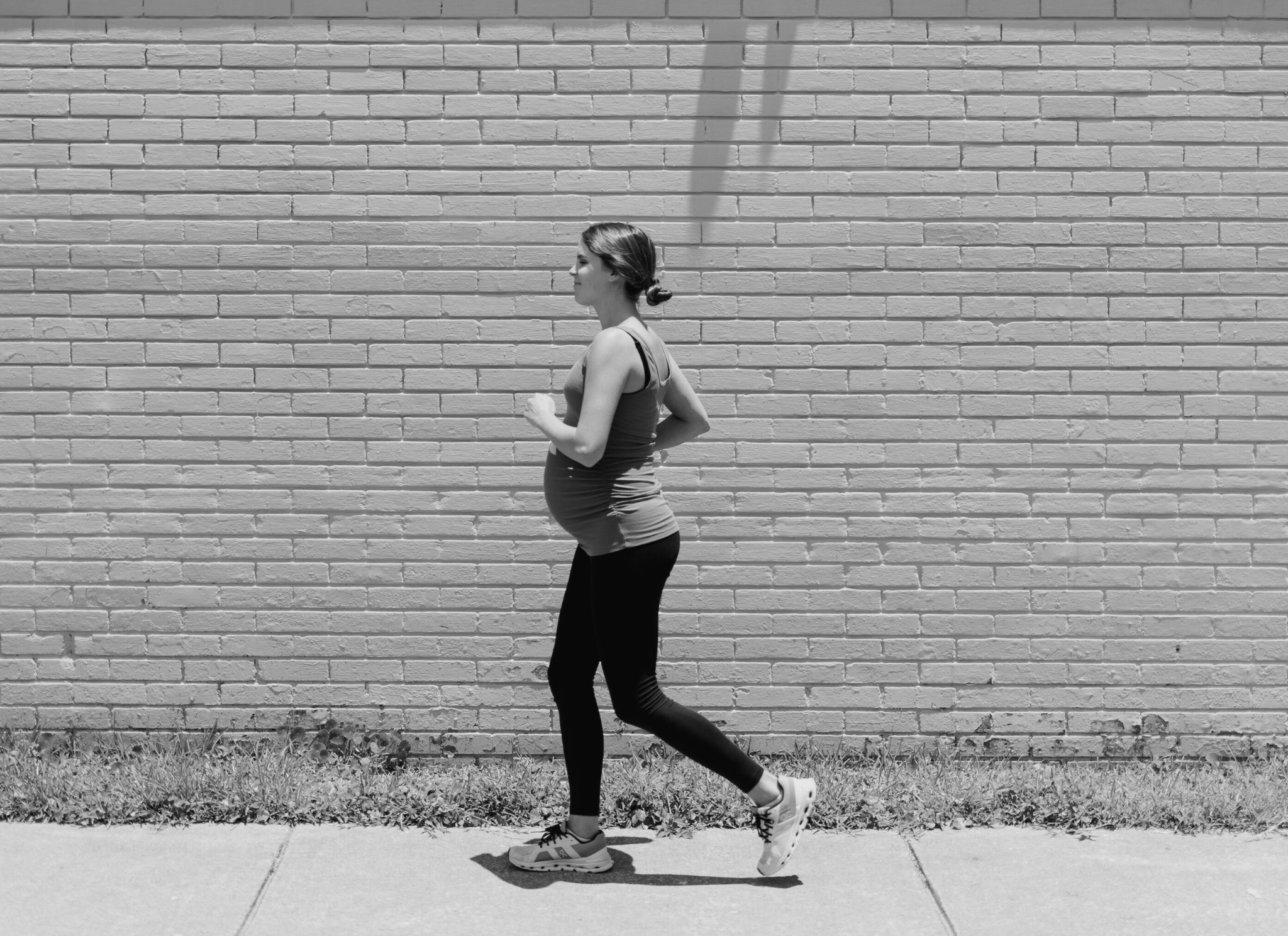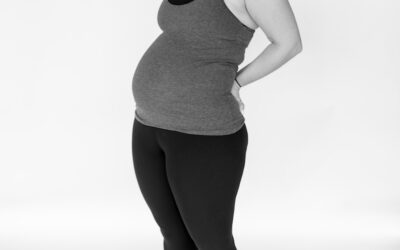If you’re wondering about running while pregnant, you aren’t alone! Questions about exercise — particularly running — are very common. Exercise is a fantastic way to keep you and your baby healthy throughout your pregnancy — and it is expert recommended!
The American College of Obstetricians and Gynecologists (AGOC) recommends 150 minutes of moderate-intensity physical activity every week when you’re pregnant. That sounds like a lot, but you just have to aim for 30 minutes of exercise, 5 times a week to hit this goal.
While there are many safe forms of exercise during pregnancy, running is often an easy choice. It doesn’t require any equipment, and as long as you have your running shoes, it can be done nearly anytime, anywhere.
Benefits of running while pregnant
There are many benefits for women who exercise during pregnancy (and their baby!) Here are some of the health benefits of running while pregnant:
- It helps you avoid weight gain beyond what is recommended.
- It reduces your risk of gestational diabetes and preeclampsia (a dangerous blood pressure condition that can develop in pregnancy).
- It can improve your cardiovascular health.
- It lowers incidences of preterm birth and low birthweight.
- It increases your chances of having a vaginal delivery and lowers chances of a cesarean.
Staying active throughout your pregnancy may also help lower your chances of developing postpartum depression (PPD).
Safety considerations
Exercise is safe for most people who are having an uncomplicated pregnancy. But before continuing or starting a running routine, keep the following in mind:
- Consult your healthcare provider: There are certain health conditions or circumstances during your pregnancy or pre pregnancy that can make exercise unsafe. Always get clearance from your obstetric healthcare provider before beginning or continuing an exercise routine during pregnancy.
- Your current fitness routine: If you’ve stopped running before pregnancy, consult your medical team before starting again. If you were an active runner pre-pregnancy, you may be able to continue running throughout your pregnancy — but always listen to your body and be prepared to modify your routine as needed.
- Modify your routine: As your pregnancy progresses, you’ll need to adjust your running routine to accommodate your changing body.
- Listen to your body: Pay attention to how you feel before, during, and after running. Stop if you experience pain, discomfort, or any pelvic floor symptoms (more on this below) and chat with your OB or pelvic floor PT.
- Watch your intensity: Pregnancy is definitely not the time to be getting personal records. ACOG recommends keeping your exercise at a moderate intensity, but how do you know what that is? One easy way to monitor your intensity is with the “talk test.” You’ll know your running effort is moderate if you can still talk comfortably as you run, but your heart and breath rates are up enough that you cannot sing!
Running while pregnant by trimester
First trimester
During the first trimester, your body produces a bunch of relaxin, a hormone that helps to loosen connective tissues throughout your body. Relaxin is great to help your body adjust with the changes of pregnancy and birth, but it can also lead to things like looser joints (instability) and changes in your posture and center of gravity. Ultimately, this can leave you at risk for developing joint pain (hello stabbing pubic bone and aching back!), and brand new trouble with coordination and balance.
To stay safe as you run:
- Run on smooth, even surfaces
- Avoid trails with uneven terrain
- Wear proper, supportive footwear
- Build a solid foundation of strength
Adding strength training to your exercise routine is one of the best ways to complement your running. Focusing on core stability and balance exercises — think exercises for your abdominals, back, hips, and pelvic floor muscles (more on this below).
Second trimester
As your pregnancy progresses and your body changes, it can help to modify some things about your running to help keep you feeling strong and injury free. Consider these modifications:
- Lean forward: One simple adjustment is to lean forward a bit while you run (think “nose over toes”). This adjustment shifts your center of mass and for most people it can make their running more efficient by reducing strain on your joints, preventing overstriding, and helping hip muscles to be more active. You can increase the incline on your treadmill or run uphill to accomplish a forward lean naturally.
- Increase your cadence: Cadence is a measure of steps per minute, and a faster cadence is easier on your joints and muscles. To increase your cadence, focus on taking shorter steps at a slightly faster pace to reduce impact on your knees, feet, and even your pelvic floor.
- Adjust Intensity: As the months pass in your pregnancy, you may have to slow your pace, reduce mileage, or alternate between running and walking as needed.
Third trimester
You may need to consider stopping running while pregnant during this trimester, especially if you experience any of the following signs:
- Urinary leakage
- Pelvic pressure or heaviness
- Abdominal coning
- Difficulty maintaining proper form
- Breathlessness that prevents conversation while running
Exercises to support running during pregnancy
Strength training is an excellent complement to running while pregnant. It can help you avoid injury and keep your body strong for whatever pregnancy (and birth) throws at you! It can also help to limit your risk of things like pelvic organ prolapse (POP) or a lingering diastasis rectus abdominis after birth.
In addition to running while pregnant, incorporate the following strength training goals:
- Breath work: Practice proper breathing techniques to engage your pelvic floor and deep abdominal muscles.
- Strength and coordination training for your pelvic floor: Your pelvic floor needs to be strong, flexible, and coordinated throughout your pregnancy and during exercise. Pelvic floor PT during your pregnancy is a great place to start.
- Core exercises: Focus on exercises that target your deep core muscles without putting excess pressure on your abdominal wall.
- Lower body stability training: Exercises like squats, walking lunges, or single leg dead lifts can be really helpful in building strength in your lower body, while also improving your balance and stability. Just make sure you are using proper form and coordinating your breath with the “work” of your exercise.
Tips to make running more comfortable during pregnancy
Remember, every pregnancy is different. While some women may need to stop running, others can continue running throughout their pregnancy. The key is to listen to your body and work closely with your healthcare provider to make sure you and your baby stay safe.
To make running more comfortable when you run:
- Get support: Compression garments or support belts can be key to comfortable movement during pregnancy, such as running. We recommend using compressive pelvic support if you have prolapse, pressure, or vulvar varicosities. This may be an external support (a jockstrap for your vagina) or an internal support like a pessary, Poise Impressa Bladder Support is an easy over-the-counter option, or you can insert a tampon to support your bladder and urethra while running.
- Invest in good running shoes: Your feet can change during pregnancy too. Make sure your shoes fit properly and provide adequate support for your arches throughout your pregnancy.
- Warm up properly: This will help prepare your body for the activity it is about to do and make you more stable on your run. Warm up with exercises like jogging and jumping jacks instead of static stretches.
- Stay hydrated: Drink plenty of water before, during, and after your run to account for increased blood volume during pregnancy.
When to stop running
Stop running (or any form of exercise) and get medical attention if you experience any of the following:
- Bleeding or fluid gushing or leaking from your vagina
- Feeling dizzy or faint
- Abdominal pain
- Shortness of breath before starting exercise
- Chest pain
- Headache
- Muscle weakness that affects your balance
- Calf pain or swelling
- Regular, painful contractions
Running while pregnant and pelvic floor health
Both running and pregnancy can put your pelvic floor muscles at risk for injury and dysfunction. Think of your pelvic floor as the trampoline holding up your growing baby. Pregnancy makes your pelvic floor work overtime and running can make it have to work even harder. Is this bad? Not necessarily, but it’s definitely something to keep an eye on! And pelvic floor physical therapy can be a really helpful tool to keep you active and pelvic floor healthy and strong.
When to call a pelvic floor PT
If you’re experiencing any of the following symptoms, it’s a good idea chat with a pelvic floor PT:
- Feeling like your insides are falling out (aka prolapse)
- Pelvic, hip, or low back pain
- Unexpected bowel or bladder leaks
- Sex becomes uncomfortable or painful
Ready to rock your pregnancy running journey? Join The V-Hive, our supportive online community, for a treasure trove of expert advice and at-home workouts to keep you running safely during pregnancy. Start your FREE 7-day trial today!
For more personalized guidance, book a virtual consultation with our experienced pelvic health specialists. We’ll work together to create a tailored running plan that keeps you and your baby safe while helping you meet your fitness goals.
Now lace up those running shoes (if you can still reach your feet) and enjoy your run — we’re here to help!




